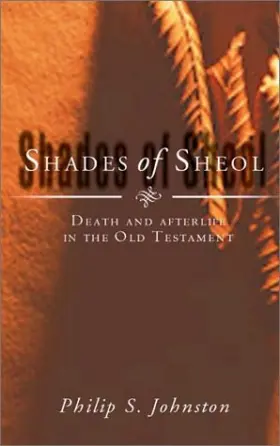

Shades of Sheol: Death and Afterlife in the Old Testament
Pages
204
Publisher
Apollos
Published
8/1/2002
ISBN-13
9780830826872
"For in death there is no remembrance of you; in Sheol who can give you praise?" (Psalm 6:5)
- Death is a profound and complex subject. How did the Israelites respond to it?
- The dead apparently went to Sheol. Where and what was it?
- The inhabitants of Sheol are sometimes called "shades." What does this indicate?
- Many ancient peoples venerated their ancestors. Did Israelites do this?
- Did anyone hope for a positive afterlife? If so, in what form?
- What about resurrection? How and when did this belief emerge?
Reviews
Evangelical evaluation of the afterlife in the Old Testament that argues a distinction between righteous believers and the unrighteous.
[Full Review]
Downers Grove, Ill.: InterVarsity Press, 2002. Pp. 288. Paper. $20.00. ISBN 0830826874. J. Edward Wright University of Arizona Tucson, AZ 85737 Shades of Sheol is a tightly organized volume with four main sections dealing with (A) death in general, (B) the underworld or the realm of the dead, (C) the dead and their connections with the living, and (D) the afterlife. The book is based on research Johnston conducted for a master�s thesis (Belfast, 1988) and a doctoral dissertation (Cambridge, 1993). Johnston succinctly presents his perspective at the outset: �Israel�s religious writers were not particularly concerned with the underworld or with the dead. They related to Yahweh in this life, and were relatively uninterested in the life hereafter� (18). Section A (chs. 1�2) treats the biblical descriptions of death and examines Israelite mourning and burial practices based on the literary and archaeological evidence. This material sets the stage for the rest of the study and in many ways simply surveys the topics and evidence that are treated more rigorously in subsequent chapters. Johnston surveys the vocabulary of death and how the related terms and themes are used in the Hebrew Bible. This treatment amounts to a theology of death in the Hebrew Bible. Definitions of the various terms are organized thematically around issues of causes, results, destiny, and the like. The author makes little use of literary distinctives; poetry, prose, and priestly prescriptions are cited side by side as if these literary genres present data in the same way with the same purposes.
[Full Review]
As its subtitle suggests, Shades of Sheol explores the topics of death and afterlife in the Old Testament. Yet, its author, Philip Johnston, Tutor at Wycliffe Hall, Oxford, provides the reader with far more than his interpretation of Old Testament texts, for scattered throughout its pages, Shades of Sheol invokes comparative Near Eastern materials and offers treatments of �other Jewish writings,� including early Christian do cuments. Johnston includes extended treatises on death (literary descriptions, theological interpretations, mourning and burial customs), the realm of the dead (Sheol and its synonyms), relations between the living and the dead (how the living viewed the dead, some names for the dead, consultation and veneration of the dead) and life after death (postmortem communion with God and resurrection from the dead). The author characterizes his work as a timely synthesis owing to what he deems to be the �very little detailed study of the topic� (16; but see below). He ambitiously aims for the book �to be accessible to all read ers familiar with the issues of biblical scholarship, from relative beginners in theological study to seasoned scholars� (19).
[Full Review]

